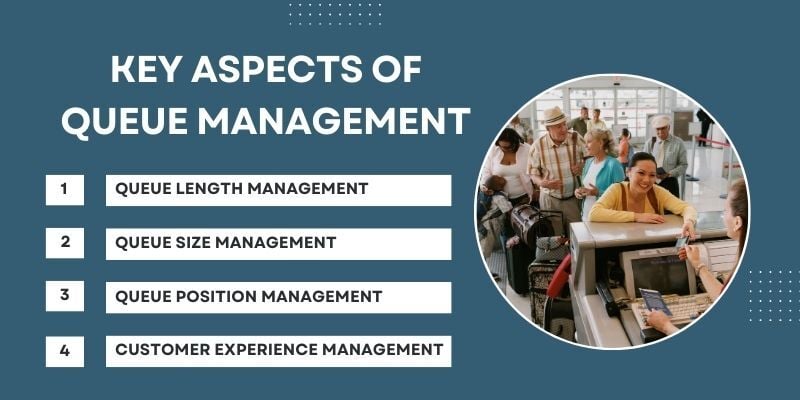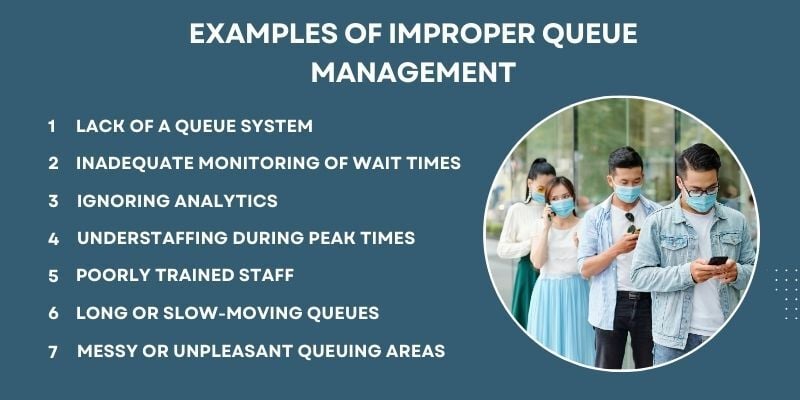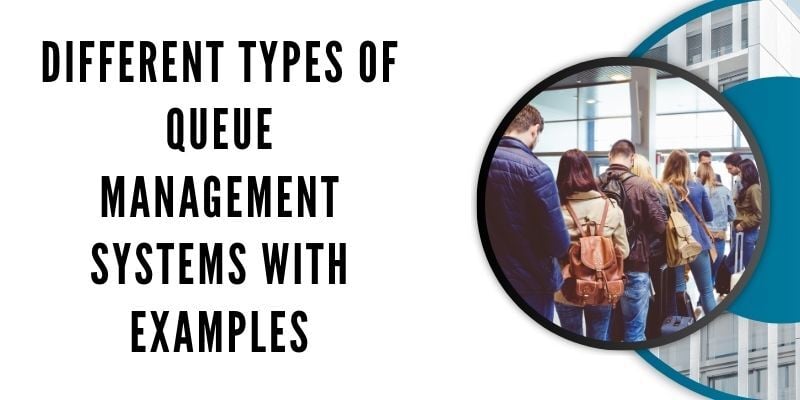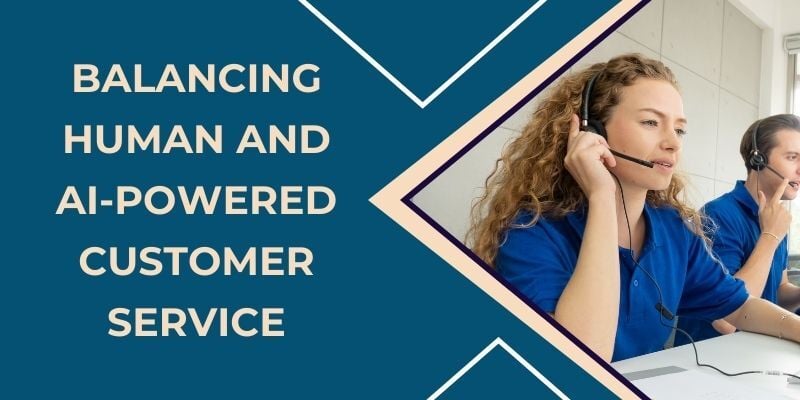Queue management is more than just an operational task. It’s essential in shaping customer experience in retail, hospitality, and healthcare industries.
Whether a customer is waiting for a product, a patient is waiting for a check-up, or a diner is waiting for a table, how a business manages these wait times affects customer satisfaction and their overall impression of the visit.
A smooth, efficient queue system reduces customer stress and keeps things moving swiftly for employees, boosting overall productivity.
But what happens when queue management goes wrong? Well, improper queue management can lead to more than frustrated customers; it can also have real financial consequences.
Longer wait times, missed services, and poor customer experiences lead to lost sales, increased operating costs, and fewer returning customers.
The financial consequences of improper queue management can seriously harm businesses, especially those that depend on quick and efficient service to make a profit. Addressing these problems is crucial for staying competitive and ensuring profitability in today’s fast-paced market.
The Cost of Waiting
Nowadays, customers expect quick service, and delays in getting what they need can harm their experience and the company’s bottom line. Whether customers are waiting in line, patients are waiting for appointments, or diners are waiting for a table, the time spent waiting directly impacts customer satisfaction and revenue.
The financial impact of poor queue management is significant, affecting everything from immediate sales and customer retention to long-term profitability.
Time as a Currency
In the US, customers collectively waste 37 billion hours each year waiting in queues. This valuable time could have been spent shopping, enjoying services, or generating business revenue.
These wasted hours lead to missed opportunities and unhappy customers. When businesses don’t manage their queues effectively, they lose out on revenue and customer loyalty. Poor queue management can also lead to customers abandoning purchases or leaving before they complete their transactions, reducing sales.
Customer Patience Thresholds

Customers don’t like to wait and won’t tolerate it for long. Studies show that 73% of customers will abandon a purchase if they have to wait more than five minutes to check out or receive service.
This impatience can cost businesses sales and their reputation. For companies that rely on quick transactions, long wait times lead to lost revenue and frustrated customers.
An efficient queue management system helps avoid these issues, ensuring businesses can retain sales and keep customers returning. Without it, businesses risk losing not just money but also loyal customers.
Impact on Brand Loyalty
Negative experiences can easily affect customer loyalty in a competitive market. Poor queue management, such as long wait times and delays, can harm a business’s relationship with its customers.
This dissatisfaction hurts immediate sales, damages a brand’s reputation, and affects customer retention. Let’s explore how the consequences of ineffective queue management impact customer loyalty and your brand’s perception.
Customer Frustration
Long wait times are one of the most significant sources of customer frustration. When customers are forced to wait, their patience often runs out, leading to annoyance.
This frustration pushes customers to competitors who offer faster service, risking lost sales and customers who may not return.
Research indicates that long wait times are key to why customers stop engaging with a brand. This emphasizes the importance of efficient queue management in retaining new and loyal customers.
Brand Perception
How customers experience your service greatly influences their view of your brand. Fast service, including efficient payment and minimal queuing, directly impacts customer perception, making them more likely to associate your brand with reliability and a positive experience.
On the other hand, slow service and long wait times can create a negative image, making your business seem disorganized or unprofessional.
This can harm your reputation and reduce consumer confidence, highlighting the far-reaching consequences of ineffective queue management.
Therefore, efficient service is not just a luxury; it’s crucial for creating a positive brand image. 73% of customers would switch to a competitor if they perceived shorter queue times elsewhere, reinforcing the importance of effectively managing queues to maintain customer loyalty and brand trust.
Financial Implications of Long Queues
The financial implications of long queues in retail stores are significant, especially in the US. For instance, a recent study revealed that 86% of consumers have left a store due to long lines, leading to a staggering potential revenue loss of $37.7 billion annually.
This means long waiting times in queues can negatively affect sales, so businesses must improve customer flow management. Customers expect faster and more convenient service, so effective queue management has become crucial for retaining customers and increasing profits.
Lost Revenue Estimates
Long queues result in substantial revenue losses for retailers. Estimates suggest that increasing the queue length from 10 to 15 people can reduce sales by up to 10%.
Research also points out that shoppers are increasingly drawn to the convenience of online shopping, especially when long queues become a common pain point.
Therefore, businesses must implement efficient queue management strategies that enhance customer experience and prevent lost sales to reduce waiting lines in retail settings.
As more consumers prioritize convenience and speed, retailers who fail to streamline their queue management risk losing out on potential sales and customer loyalty.
Missed Opportunities
Long queues lead to missed opportunities and lost sales. Many shoppers abandon their carts after waiting more than eight minutes, and an even larger percentage leave due to extended wait times at checkout. Studies show that 77% of consumers are less likely to return to a store if they experience long checkout lines.
This results in immediate lost sales and diminishes the potential for customer retention. If delays spoil an impatient customer’s experience, they are less likely to become repeat buyers.
The financial losses due to poor queue management are even more severe for businesses that rely on repeat customers.
The Ripple Effect of Poor Queue Management
Queue management affects much more than service speed. Poor queue management can hurt a business’s reputation and customer loyalty, influencing whether customers return.
Customers with negative waiting experiences may spread their frustration through word-of-mouth, further damaging the brand’s image.
The consequences of poor queue management aren’t just about lost sales—they can shape how customers feel about your business. Fixing this can go a long way in improving satisfaction and encouraging return visits.
Negative Word-of-Mouth

When customers face long waits, dissatisfaction often leads to negative reviews or social media posts. Customers who suffer a bad interaction are 50% more likely to share it on social media than those with a good experience.
Since negative feedback spreads quickly, prolonged wait times can stop others from visiting, resulting in lost potential business.
This chain reaction of negative word-of-mouth can make it harder for businesses to attract new customers, creating a long-term impact that affects more than just one unhappy customer.
Customer Turnover
Long wait times don’t just result in a one-time loss of sales; they can cause customers to stop doing business with you permanently. Customers who feel their time is wasted will likely turn to competitors offering faster service.
Long delays are a significant reason customers stop returning to a brand. They are unlikely to return once they lose trust in a company’s ability to provide a quick and positive experience.
This significantly increases the financial risks of mismanaged queues, leading to long-term customer loss that can be difficult to recover from, especially for businesses that rely on repeat customers.
Addressing these queue management issues can help businesses reduce immediate financial risks and protect their long-term customer base and reputation.
Operational Inefficiencies
Poor queue management can cause major problems for both employees and businesses. Without a good system, businesses struggle to staff the right number of people during busy times, leading to issues such as too few or too many workers.
This raises costs and affects employee morale and productivity, making it more challenging for the business to run efficiently.
Understaffing vs. Overstaffing
During peak times, businesses often struggle with staffing. Without a proper queue management system, they can’t predict customer demand well, resulting in either understaffing or overstaffing.
Understaffing causes delays and stress for workers, while overstaffing wastes resources and decreases productivity. Both situations lower employee satisfaction and contribute to operational problems.
Businesses with poor queue management often see higher turnover rates because the stress from these issues negatively affects workers. Ensuring the correct number of staff helps the business run smoothly, reduces stress, and improves productivity.
Resource Allocation
Inefficient queue management can lead to poor resource use, raising operational costs. When businesses can’t predict how many customers they will have, they may allocate too many or too few resources. This leads to extra costs, like having too much staff when business is slow or not enough when it’s busy.
This wasteful use of resources affects profitability. By improving queue management, businesses can better plan and allocate resources, reducing unnecessary costs and improving financial outcomes.
These inefficiencies highlight the economic consequences of bad queue management, directly impacting profitability and efficiency.
Key Aspects of Queue Management

Managing queues isn’t just about cutting wait times—it’s about improving the flow of customers, streamlining services, and ensuring a better overall experience. Here are the critical components businesses should focus on when improving their queue management strategies:
1. Queue Length Management
Queue length management is about controlling the number of customers waiting at any given time. Businesses can better understand peak demand and adjust service capacity by measuring the average length of queues.
This helps balance customer flow and ensure reasonable wait times, preventing frustration. Effectively managing queue length leads to a smoother customer experience and operational efficiency, avoiding the costly effects of inefficient queue management.
2. Queue Size Management
Queue size refers to the total number of people in the system, including those served. Proper queue size management helps prevent congestion by measuring and adjusting the number of customers in the system.
This allows businesses to modify staffing levels or adjust service methods to maintain smooth service and avoid delays.
3. Queue Position Management
Queue position management tracks where each customer is in line. Knowing customers’ positions allows businesses to make smarter staffing decisions and streamline service. This helps ensure that high-priority customers or those in urgent need are quickly served.
Managing queue positions minimizes wait times and improves service delivery, ensuring the process is orderly and efficient.
4. Customer Experience Management
Managing the customer experience during wait times is essential for maintaining satisfaction. Entertainment, updates, or estimated wait times can keep customers engaged and make their wait more pleasant.
Training staff to handle queues efficiently while creating a positive atmosphere is key to improving customer experience. A well-managed customer queue reduces frustration and enhances loyalty, demonstrating the importance of effective queue management to avoid the costly effects of inefficient processes.
Examples of Improper Queue Management

How businesses manage their queues directly impacts customer satisfaction, operational efficiency, and profitability. Improper queue management can cause customer frustration, result in lost sales, and harm a business’s reputation.
Below, we discuss several common mistakes in queue management and their far-reaching consequences:
1. Lack of a Queue System
When there is no clear queue system, customers are left to figure out where to stand, leading to confusion and frustration. A lack of order creates unnecessary stress in a physical store or a virtual waiting room.
Customers may feel ignored or uncertain, prompting them to abandon their purchases or leave the store entirely. For businesses, this can mean lost revenue and a negative customer experience that can discourage repeat visits.
Businesses must implement a well-organized queue management system to avoid chaos and ensure customers feel valued.
2. Inadequate Monitoring of Wait Times
One of the biggest pitfalls in queue management is failing to monitor wait times effectively. Businesses cannot adjust staffing levels to match demand without tracking customer wait times. This leads to understaffing during busy periods, which causes long delays.
On the other hand, it may also result in overstaffing during slow times, wasting resources. Without monitoring, businesses miss the opportunity to provide timely service, which can frustrate customers and negatively impact their overall experience.
Consistent tracking and real-time adjustments help ensure that wait times are minimized and service quality is maintained.
3. Ignoring Analytics
Queue analytics provide valuable data about customer flow, peak times, and service bottlenecks. Ignoring this data means missing out on opportunities to optimize retail service processes and improve customer satisfaction.
By analyzing trends, businesses can predict high-traffic times, allocate resources more effectively, and adjust queue management strategies.
For example, queue length data can highlight when extra registers or checkout counters should be opened. Failing to use analytics can lead to inefficient operations, ultimately affecting profitability and customer retention.
4. Understaffing During Peak Times
Poor queue management is one of the most common causes of understaffing during peak hours. When businesses don’t plan for surges in customer demand, employees can become overwhelmed, and wait times can increase significantly.
This frustrates customers and leads to employee burnout as they struggle to keep up with the demand. In extreme cases, understaffing can result in missed sales opportunities and long-term damage to the business’s reputation.
Customers who experience long waits during busy times may never return, making it crucial for businesses to forecast demand and staff accordingly.
5. Poorly Trained Staff
Poor staff training can lead to inefficiencies even with the right retail queue management system. Employees must understand how to manage queues effectively, communicate with customers, and keep the process moving smoothly.
Staff not trained in handling high-stress situations or lacking knowledge of the queue system can inadvertently slow down service, leading to wait times longer.
Additionally, customer frustration increases when employees are unprepared to handle customer inquiries or complaints during wait times. Practical training ensures that staff can deal with queues efficiently, creating a smoother, more pleasant experience for everyone.
6. Long or Slow-Moving Queues
Long queues drive customers away. Many customers abandon their purchases when they wait too long or the queue moves too slowly. This can happen both in physical stores and online checkout lines.
Slow-moving queues often signal inefficiency and make customers feel their time is not valued. Moreover, they damage the business’s reputation and reduce the likelihood of repeat visits.
Therefore, businesses must streamline their service processes to reduce customer waiting times in queues and ensure faster, more efficient checkouts.
7. Messy or Unpleasant Queuing Areas
A clean, organized, and comfortable queuing area is essential for creating a positive customer experience. When customers wait in a messy, disorganized, or uncomfortable space, their overall experience is negatively impacted.
A disordered queue area can make customers uneasy and prompt them to abandon the line or leave the store. A negative environment, such as dirty floors, unclear signage, or uncomfortable seating, can make the wait seem longer.
Investing in a clean and orderly queuing area helps create a better atmosphere for customers and makes the wait more tolerable. This simple yet important aspect of queue management can improve customer satisfaction and loyalty.
By addressing these common pitfalls in queue management, businesses can enhance customer satisfaction, reduce lost sales, and improve operational efficiency. Effective queue flow management ensures a seamless customer journey by minimizing bottlenecks and optimizing service speed.
Case Studies and Examples
Here are a few examples of businesses that have faced financial consequences due to poor queue management and how they’ve turned their strategies around to improve customer experience:
Kohl’s:
Kohl’s, a major US retailer, experienced significant customer frustration due to long wait times at checkout, particularly during busy periods. To address this issue, Kohl’s implemented Wavetec’s queue management system, which optimized customer flow and reduced waiting times.
The system helped streamline the checkout process by directing customers to available counters and improving overall efficiency. As a result, Kohl’s experienced a boost in customer satisfaction, reduced cart abandonment, and increased sales.
This success highlights the importance of efficient queue management in enhancing customer experience and revenue.
Walmart
Walmart experienced significant customer frustration due to long checkout lines, especially during peak shopping hours. Shoppers often abandoned their carts, leading to lost sales.
In one instance, a frustrated customer shared their experience on social media, describing a line of 30 people at a self-checkout lane. Many customers felt that the self-checkouts were no longer faster than traditional cashier lanes, contributing to a negative shopping experience.
As a result, Walmart worked to address this issue, including scaling back the number of self-checkout machines and offering more cashier lanes to ensure smoother and quicker queues.
Tony’s Fresh Market:
Tony’s Fresh Market, a US-based grocery chain, struggled with inefficient queue management, especially during peak shopping. After implementing Wavetec’s queue management system, the company significantly reduced customer wait times and improved the shopping experience.
The system helped streamline the flow of customers to checkout counters, minimizing the chances of cart abandonment and improving customer satisfaction. As a result, Tony’s Fresh Market saw increased repeat customers and overall revenue.
FAQs
1. What are the main consequences of poor queue management?
Poor queue management can lead to customer frustration, lost sales, and damaged reputation. Customers may abandon purchases due to long waits or a disorganized system.
This harms the business’s image, as unhappy customers may share their experiences, discouraging new ones. Additionally, inefficient queue management increases operational costs and can result in higher employee burnout and lower customer retention.
2. What impact does poor queue management have on sales?
Long or poorly managed queues can significantly impact sales. Customers who wait too long may abandon their purchases, losing revenue. Additionally, long waits can damage a business’s reputation, discouraging potential customers from visiting in the future. This affects not only immediate sales but also long-term customer loyalty.
3. Can poor queue management affect employee morale?
Yes, poor queue management can negatively affect employee morale. When there aren’t enough staff or employees are overwhelmed with long lines, it can lead to stress and frustration.
Understaffing during busy times or poor queue organization can make employees feel overworked, lowering their job satisfaction and productivity. This can lead to higher turnover rates and challenges in maintaining an efficient workforce.
4. What are the costs associated with long queues?
Long queues result in both direct and indirect costs. Direct costs include lost sales as customers abandon purchases due to long waits. Indirectly, businesses may incur higher operational expenses from misallocated staffing resources, increased employee turnover, and damage to their reputation, which leads to fewer new customers.
Conclusion
Improper queue management can significantly impact a business’s revenue, causing immediate sales losses from abandoned purchases and long-term harm to customer loyalty and reputation. Issues like understaffing, excessive wait times, and customer dissatisfaction directly affect a company’s financial performance.
Businesses must invest in effective queue management systems to avoid these costly effects. By optimizing customer flow and enhancing the overall service process, they can increase customer retention, improve revenue, and streamline operations.
Prioritizing efficient queue management is essential to maintain a positive customer experience and safeguard long-term business success.
BOOK A FREE DEMO





